Scroll to:
Investigation of the Sorption of Heavy Metals by Terrestrial Ecosystems in Areas of the City of Chita with Various Anthropogenic Loads
https://doi.org/10.23947/2541-9129-2025-9-3-196-207
EDN: YKMQQT
Abstract
Introduction. Environmental pollution with heavy metals is one of the most pressing environmental problems, as these substances can have a negative impact on ecosystems and living organisms. In particular, the accumulation of heavy metals in plants in urban ecosystems is an issue that has been widely studied, but many aspects of the problem remain unintelligible. For example, existing research does not always consider the influence of different environmental factors on metal sorption processes. This creates gaps in understanding the mechanisms of interaction between plants and pollutants. The current study aims to investigate the dependence of heavy metal sorption by the Scots pine (Pinus sylvestris) on the level of environmental pollution. The goal is to determine how metal accumulation indicators change depending on the growing conditions, allowing for a more accurate assessment of this plant's role in urban ecology.
Materials and Methods. The research was conducted in the city of Chita in the Trans-Baikal Territory. Scots pine is a widespread species of pine in this region, therefore, the bark of the Scots pine, as well as soil samples from sites in Chita that were exposed to high levels of human activity served as the basis for the study. Selection of sites was based, among other factors, on complex air pollution index (API5) in Chita. After collecting samples, they were quartered, dried, and ground into a fine powder. Then, the bark and soil were heated in a muffle furnace at 600°C. The burnt soil and pine bark ash were analyzed using methods commonly used in wood chemistry, including a spectrometric analysis on a Shimadzu AA-6200 atomic absorption spectrometer. The acidity was determined by the potentiometric method in a chloride extract. For this purpose, a 1M KCl solution (pH = 6.0) was used, as well as standard buffer solutions (pH 4.01; 6.86; 9.18) for instrument calibration. Suspensions were prepared by adding 75 ml of extractant to 30 g of soil, stirring for one minute. The pH was then measured after the readings stabilized. In parallel, a control experiment was conducted without a soil sample.
Results. Analysis of the data on seasonal changes in the ash and moisture content of Scots pine bark showed that they slightly increased in the summer and autumn months. During the study, we also obtained data on the distribution of heavy metals in the soil and bark of Scots pine depending on the season of the year. It was found that the highest levels of copper in the soil and bark of Scots pine were observed in Batareinaya Sopka, exceeding the maximum permissible concentration by 11 times, followed by Granitnaya Street, where the maximum permissible concentration was exceeded by 5 times. Zinc levels in the soil were high at three locations: Sosnovy Bor, Memory Park, and Batareinaya Sopka, exceeding the maximum permissible concentration by 1.77, 1.74 and 1.5 times, respectively. Lead levels were within the MPC at all seven locations. There were no seasonal changes in the content of heavy metals in the soil and bark. Thus, the study revealed the dependence of the content of heavy metals in the soil and bark of the Scots pine on the degree of anthropogenic load in the districts of Chita in the Trans-Baikal Territory.
Discussion. The results of the study demonstrated the correlation between the concentration of heavy metals in soil and bark samples of Scots pine and the degree of anthropogenic load. Therefore, the Scots pine can be considered a valuable object for monitoring heavy metal pollution, as it combines high sensitivity to man-made effects, resistance to adverse conditions and long-term ability to accumulate toxic substances. The data obtained support the idea of including the Scots pine in environmental monitoring systems, particularly in areas with developed industrial and transportation infrastructure. Future research could focus on developing standardized methods for using pine in bioindication, as well as studying its phytoremediation potential in conditions of chronic pollution.
Conclusion. The study expands our understanding of the mechanisms behind the migration and accumulation of heavy metals in urban ecosystems, especially in areas with a harsh continental climate. The findings can be used to improve urban planning, reduce the negative impact on public health, and develop sustainable strategies for areas with high levels of anthropogenic load.
For citations:
Turusheva T.V., Esipov V.E. Investigation of the Sorption of Heavy Metals by Terrestrial Ecosystems in Areas of the City of Chita with Various Anthropogenic Loads. Safety of Technogenic and Natural Systems. 2025;9(3):196-207. https://doi.org/10.23947/2541-9129-2025-9-3-196-207. EDN: YKMQQT
Introduction. One of the most urgent problems in modern ecology is environmental pollution by heavy metals. These substances [1] belong to the first and second hazard classes, as they have a significant negative impact on biological processes in ecosystems [2]. In addition, heavy metals can accumulate in living organisms, soil, and water bodies [3]. Entering the human body in small doses through the gastrointestinal tract, respiratory system, or skin, these substances are invisible to the naked eye, as they lack taste, smell, and color. However, their long-term accumulation [4] in human bones, liver, and brain can lead to severe diseases such as neurological disorders and cancer. Recently, there has been a growing interest in the scientific community [6] in the topic of heavy metal accumulation [5] by plants in urban ecosystems. In his work, the author [7] conducts a comparative analysis of the accumulation of heavy metals in the leaves, root and bark of the Siberian peashrub (Caragana arborescens) under conditions of anthropogenic impact on the territory of the Trans-Baikal Territory. Studies by another author show [8] that in urbanized landscapes, especially near highways, pine bark can accumulate significant concentrations of lead, cadmium, zinc, and copper, acting as kind of "storehouse" for these pollutants. Due to the mountainous and hollow location of the city of Chita and its high level of air pollution, the Scots pine tree absorbs pollutants on its needles and bark throughout the year. Therefore, research on the accumulation of heavy metals in coniferous trees in the climatic conditions of the Trans-Baikal Territory remains insufficiently explored, making this work particularly relevant.
It has been established [9] that the place of growth significantly affects the quantitative content of heavy metals in plants. The main sources of heavy metal pollution in the environment of the Trans-Baikal Territory are industry, vehicle emissions, and private sector using coal for furnace heating. The problem of air pollution in the Trans-Baikal Territory is particularly acute, as the city of Chita has been among the cities with the highest levels of air pollution for several years. This problem is aggravated by natural and climatic conditions and the mountainous and hollow location of the city. In winter, the Siberian anticyclone dominates the territory of the Trans-Baikal Territory, which is characterized by low temperatures and lack of air mass transfer. This results in a temperature inversion over Chita that prevents normal dispersion of emissions. Therefore, monitoring of the state of atmospheric air by priority pollutants is necessary in many cities [10].
The Scots pine (Pínus sylvéstris) is of considerable interest in the context of phytoremediation of urban areas contaminated with heavy metals due to a number of unique adaptive mechanisms and high resistance to adverse environmental conditions. As an evergreen coniferous species, the pine accumulates pollutants all year round [11], especially effectively trapping metal-containing aerosols and dust particles that settle on the surface of the needles.
The bark of the Scots pine is a unique biological filter that plays a significant role in the accumulation of heavy metals from the urban environment. Unlike other tree tissues, the bark has a strong sorption capacity due to its porous structure and high lignin content, as well as the presence of phenolic compounds that bind metal ions actively. The process of metal accumulation in the bark is complex. Primary deposition occurs through direct contact with airborne particles, such as particles of tire wear, brake pads and pavement, which settle on the rough bark surface. Secondary accumulation occurs through bark diffusion processes, when soluble forms of metals enter the outer layers of bark through rainwater or condensation, becoming bound to cell walls through chelation with organic acids and tannins.
Thus, the aim of this research is to investigate the relationship between the sorption of heavy metals by the Scots pine and the level of pollution in their growing environment, taking into account the sharply continental climate and the mountainous and hollow location of the city of Chita in the Trans-Baikal Territory.
Materials and Methods. The bark of the Scots pine and soil samples taken from seven sites in Chita, which differed in the level of anthropogenic load, were used as the object of research (Fig. 1): site No. 1 — Pioneer Park (Zhuravleva St.); site No. 2 — Memorial Park (Petrovsko-Zavodskaya St.); site No. 3 — stadium SibVO (Kaidalovskaya St.); site No. 4 — Batareinaya Sopka; site No. 5 — Sosnovy Bor; site No. 6 — Bypass Highway; site No. 7 — Granitnaya St..
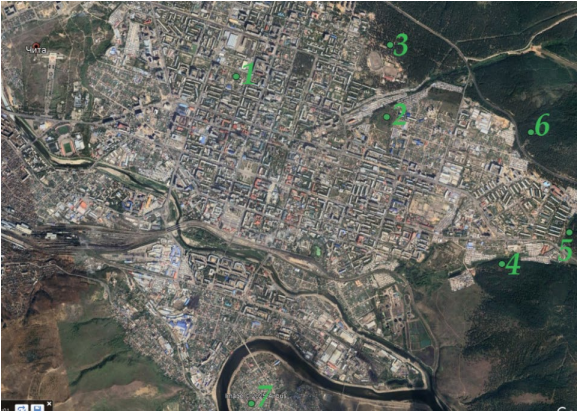
Fig. 1. Sampling map
Sampling was conducted during the seasons from spring 2024 to winter 2025. At each sampling location, 10–12 trees were selected and bark samples were collected. The top layer of bark was discarded, and then the fresh layer below was carefully removed using a knife. Soil samples were collected at a distance of 1.5 meters from the trees at a depth of 10 cm below the surface.
The samples were quartered, dried, and ground to a fine-grained state, after which the bark and soil were thermally treated in a muffle furnace at 600°C. The burnt soil and ash of the bark of the Scots pine were studied according to the methods adopted in wood chemistry [12], using the spectrometric method on a Shimadzu AA–6200 atomic absorption spectrometer. Sample preparation for analysis on an atomic absorption spectrometer included taking a 5.00 g sample, placing it in a conical flask, wetting it with water and adding 15 ml of chemically pure hydrochloric acid. Then the mixture was boiled for 2–3 minutes, 5 ml of 2M chemically pure nitric acid was added and the contents of the flask were brought to the state of dry salts. After that, the flasks were removed from the stove, 30 ml of 5M hydrochloric acid 1:1 was added and boiled again until dry salts were obtained, then HCl 1:1 was added again and boiled for 3 minutes. The flasks were cooled to room temperature, and then the volume of the solution was adjusted to 200 ml and filtered through blue ribbon filters. The resulting filtrate was analyzed on Shimadzu AA-6200 and Agilent 240 FS AA devices. The data was processed and organized into tables, and then the diagrams were constructed indicating the MPC in the soil (HN 2.1.7.2041–06). Acidity was determined by the potentiometric method in a chloride extract using a 1M KCl solution (pH=6.0), as well as standard buffer solutions (pH 4.01; 6.86; 9.18) for calibration of the device. The suspension was prepared by adding 75 ml of extractant to 30 g of soil, stirring for a minute, and pH was measured after stabilization of the readings. In parallel, a control experiment was conducted without a soil sample.
Results. During the course of the study, the moisture content and ash content of Scots pine bark, as well as soil moisture levels, were measured. An increase in moisture levels led to an increase in the mobility of heavy metals in the soil, and as a result, their bioavailability to plants increased (Tables 1–3).
Table 1
Seasonal dynamics of moisture changes in the Scots pine bark in 2024, %
|
Sampling site |
Season |
Standard deviation |
||
|
Spring |
Summer |
Autumn |
||
|
Pioneer Park |
6.4 |
7.6 |
8.1 |
0.8737 |
|
Memory Park |
5.9 |
7.3 |
7.9 |
1.0263 |
|
SibVO Stadium |
8.3 |
9.1 |
10.1 |
0.9018 |
|
Batareinaya Sopka |
10.2 |
11.3 |
12.6 |
1.2014 |
|
Sosnovy Bor |
7.3 |
8.7 |
9.8 |
1.2530 |
|
Bypass Highway |
6.1 |
7.5 |
8.2 |
1.0693 |
|
Granitnaya St. |
8.5 |
9.2 |
10.3 |
0.9074 |
Table 2
Seasonal dynamics of ash content in the Scots pine bark in 2024, %
|
Sampling site |
Season |
Standard deviation |
||
|
Spring |
Summer |
Autumn |
||
|
Pioneer Park |
6.7 |
7.1 |
6.9 |
0.2000 |
|
Memory Park |
4.9 |
5.3 |
5.5 |
0.3055 |
|
SibVO Stadium |
4.8 |
5.1 |
5.4 |
0.3000 |
|
Batareinaya Sopka |
5.2 |
4.5 |
4.7 |
0.3606 |
|
Sosnovy Bor |
4.9 |
4.7 |
5.2 |
0.2517 |
|
Bypass Highway |
3.9 |
4.2 |
4.3 |
0.2082 |
|
Granitnaya St. |
4.8 |
5.0 |
5.4 |
0.3055 |
An analysis of the data on moisture and ash content of pine bark revealed that, on average, the bark had low humidity levels in all areas except for Batareinaya Sopka and Granitnaya Street. This could be explained by the fact that these locations were further away from the city and therefore received more moisture and lost it to a lesser extent due to sunlight exposure. The humidity increased slightly from winter to autumn throughout the year, while the ash content remained approximately the same. Although the ash content of the bark did not directly influence the accumulation of heavy metals, it could indirectly affect this process through the ratio of organic and inorganic substances in the bark. This, in turn, could influence the plant's ability to accumulate heavy metals [13].
Table 3
Seasonal dynamics of soil moisture changes in 2024, %
|
Sampling site |
Season |
Standard deviation |
||
|
Spring |
Summer |
Autumn |
||
|
Pioneer Park |
3.0 |
3.1 |
3.6 |
0.3215 |
|
Memory Park |
2.1 |
2.3 |
2.5 |
0.2000 |
|
SibVO Stadium |
1.7 |
1.8 |
2.1 |
0.2082 |
|
Batareinaya Sopka |
2.4 |
2.5 |
3.0 |
0.3215 |
|
Sosnovy Bor |
3.0 |
3.2 |
3.8 |
0.4163 |
|
Bypass Highway |
3.7 |
3.9 |
4.2 |
0.2517 |
|
Granitnaya St. |
2.6 |
2.7 |
3.1 |
0.2646 |
According to the data collected, soil moisture in these areas was low and increased slightly during the summer and autumn periods.
Another important factor in the sorption of heavy metals from soil was its acidity. Podzolic soils were the most common type in the studied region. Their type was previously assessed by morphological features such as color and structure, which allowed us to identify genetic horizons. The analyzed samples were characterized by a gray-brown color and contained small aggregates, which was typical for sod-podzolic soils with a pH ranging from 4 to 7.
The data collected are presented in Table 4.
Table 4
pH values of soil extracts
|
Sampling site |
pH value |
|
Pioneer Park |
6.3 |
|
Memory Park |
5.5 |
|
SibVO Stadium |
6.3 |
|
Batareinaya Sopka |
4.9 |
|
Sosnovy Bor |
5.3 |
|
Bypass Highway |
6.6 |
|
Granitnaya St. |
5.6 |
The conducted studies of Chita's soil cover revealed a number of interesting patterns. Among them, the data from the territories of Batareinaya Sopka and Sosnovy Bor were of particular concern. There, abnormally low pH values were recorded, which was surprising for coniferous forests. The analysis of the wind rose and the locations of industrial facilities indicated that these natural ecosystems actually became accumulators of pollutants from thermal power plants, boiler houses, and busy highways. The SibVO Stadium and the Bypass Highway showed good performance. These territories were characterized by acidity values in the range of 6.3–6.6 pH, which was consistent with the results of morphological studies of the soil cover and indicated its compliance with the sod-podzolic type. Granitnaya Street with its moderately acidic soils was a typical example of an urbanized area with a predominance of traffic load. Such results require further investigation, especially considering long-term trends and potential consequences for urban ecosystems.
When studying the soil [14] and the bark of the Scots pine, special attention was paid to the following heavy metals: Cu, Zn, Pb. Each element has its own lamp emitting light with a certain wavelength: copper — 324.7 nm,
lead — 283.3 nm, zinc — 213.9 nm. The obtained laboratory data are presented in Figures 2–7.
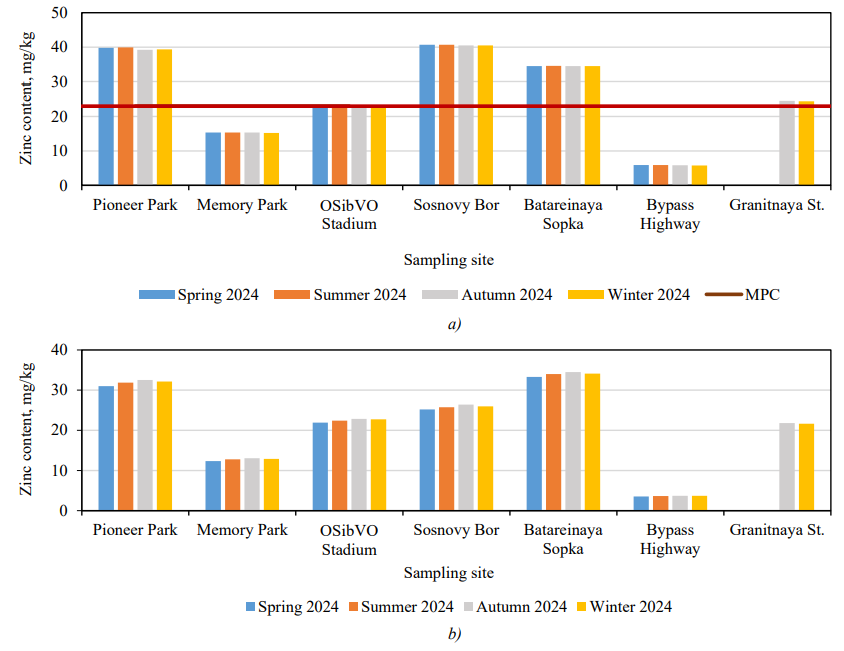
Fig. 2. Zinc content: a — in the soil; b — in the bark

Fig. 3. Dependence of zinc content in the bark on the content in the soil
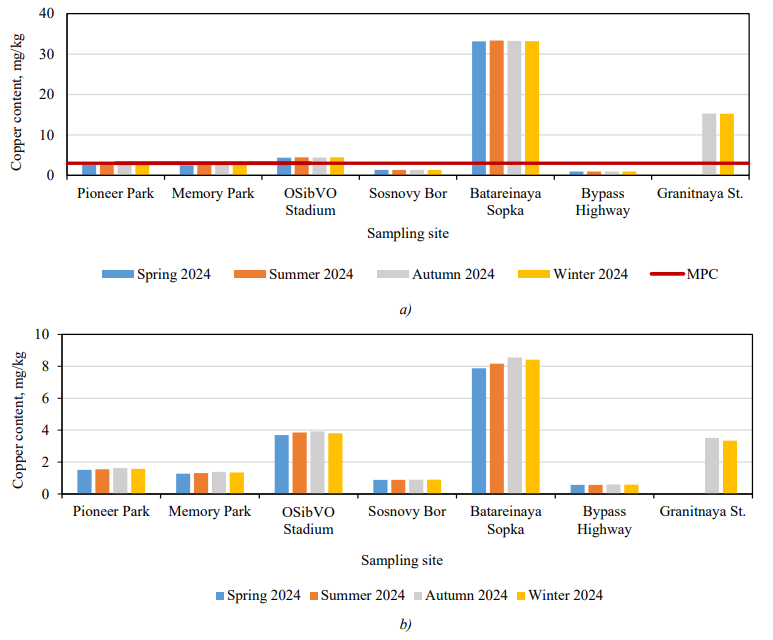
Fig. 4. Copper content: a — in the soil; b — in the bark

Fig. 5. Dependence of copper content in the bark on the content in the soil
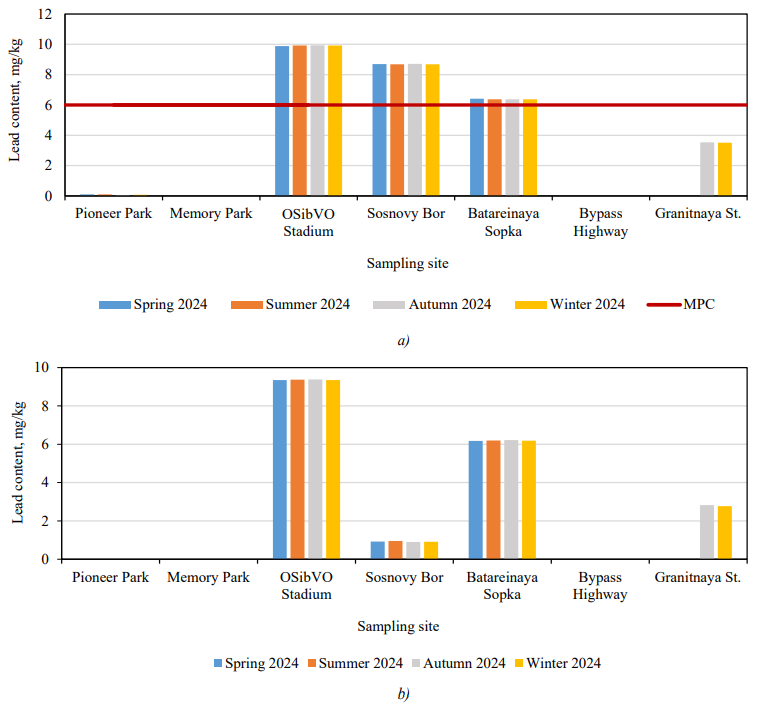
Fig. 6. Lead content: a — in the soil; b — in the bark
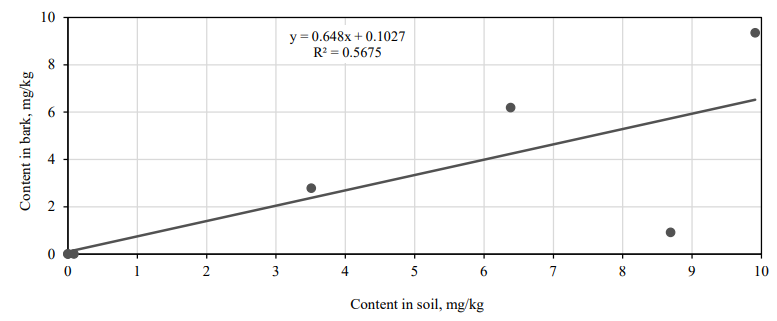
Fig. 7. Dependence of lead content in the bark on the content in the soil
After analyzing the results, it can be noted that the levels of heavy metals in the Scots pine bark showed a slight increase from spring to autumn, while soil levels remained relatively stable. The highest levels of soil pollution were observed in areas such as Batareinaya Sopka, Sosnovy Bor, Memory Park, Granitnaya Street, and SibVO. The analysis revealed the dependence of levels of heavy metal contamination in the Scots pine soil and bark on the level of anthropogenic load in the respective areas.
The research found a high concentration of copper in the soil at Batareinaya Sopka, which was 11 times higher than the maximum permissible level. This could be due to the presence of car repair shops and highways nearby, which could lead to increased levels of heavy metals in wastewater. Site No. 4 had a high level of air pollution due to its location on the leeward side of Chitinskaya CHPP-2. The samples taken near Granitnaya Street and the SibVO Stadium showed that the copper content was 5 and 1.5 times higher than the MPC, respectively. However, in other areas, the concentration remained within the sanitary standards.
High zinc content in the soil has been observed at three locations: Sosnovy Bor, Memory Park, and Batareinaya Sopka, with excesses of MPC by 1.77, 1.74 and 1.5 times, respectively. Additionally, a slight excess of the maximum permissible concentration was detected in the areas of the SibVO Stadium and Granitnaya Street. In other areas the indicators were within the normal range. Lead content in the soil exceeded the maximum permissible concentration in near the SibVO Stadium by 1.6 times, near the Sosnovy Bor by 1.45 times and near the Batareinaya Sopka. No lead was found in areas such as Memorial Park, Pioneer Park and Bypass Highway.
The excess of the maximum permissible concentration of lead was explained by the negative impact of energy and motor transport enterprises. Thus, in the ash deposits at CHPP-2 after coal combustion, lead content was 50–60% higher than the toxicity threshold. The wind carried toxic dust from the ash and slag dumps to all adjacent areas [15]. High levels of lead in soil were also caused by the slow removal of lead from soil. The rate of leaching varied between 4 and 30 grams per hectare per year, which led to an increase in lead concentration, especially in areas near highways.
There were no seasonal changes in the content of heavy metals in the soil. A slight fluctuation in the heavy metals content was observed in the bark. The levels increased gradually from spring to autumn, and then decreased slightly in winter and spring. This could be related to the growth cycle of the trees.
At the Sosnovy Bor site, lead content in the bark was almost not detected. This discrepancy in the overall picture could be explained by lead's strong binding [16] to organic matter in soils with high humus content, as well as its formation of phosphates and carbonates, making it practically inaccessible to plants. Additionally, the absorption of heavy metals by plants was influenced by the ionic composition of the soil. For example, the presence of competing Ca2⁺ and Al3⁺ ions could inhibit the absorption of lead by roots [17]. In soils with high concentrations of these elements, Pb²⁺ supply to plants decreased, while zinc and copper [18] continued to accumulate due to specialized transport mechanisms.
The cleanest section in this study was the Bypass Highway, since the sampling site in this case was far from the sources of pollution.
Discussion. The results of the study revealed significant soil contamination with heavy metals (Pb, Zn, Cu) in several areas of the city. The maximum permissible concentration (MPC) was exceeded in some areas, with the highest levels recorded at Batareinaya Sopka (copper — 11 times, zinc — 1.5 times), Granitnaya Street (copper — 5 times) and in the area of the SibVO Stadium (lead — 1.6 times). These findings indicate a high anthropogenic load due to the proximity of industrial enterprises, highways and historical sources of pollution, such as landfills and boiler houses. At the same time, seasonal fluctuations in the content of heavy metals in the soil were found to be relatively minor, suggesting that the pollution is more likely to be chronic in nature.
Special attention was paid to the impact of the hollow location of Chita on the environmental situation. The mountainous and hollow relief contributes to the accumulation of pollutants in the surface layer of the atmosphere and soil, limiting their natural dispersion. This is aggravated by the prevailing climatic conditions, such as a sharply continental climate with low precipitation, which increases the concentration of pollutants. The research results confirm that these factors create unfavorable conditions for natural self-purification of ecosystems, especially in areas with high anthropogenic load.
An important aspect of the research was the study of the effect of soil acidity on the mobility and accumulation of heavy metals. It has been found that in acidic soils (pH 4.9–5.6), such as in the areas of Batareinaya Sopka and Sosnovy Bor, the availability of metals to plants increased, which contributed to their accumulation in the bark of pine trees. At the same time, neutral and slightly alkaline soils (pH 6.3–6.6) demonstrated lower mobility of heavy metals, which reduced their bioavailability. These data emphasize the importance of considering pH when assessing pollution risks and designing remediation measures.
Thus, the Scots pine is a valuable tool for monitoring environmental pollution by heavy metals in a sharply continental climate and the hollow location of the city of Chita, combining high sensitivity to man-made impacts, resistance to adverse conditions and the long-term ability to accumulate toxins, thereby removing them from the circulation of substances. The data obtained substantiate the expediency of including this species in environmental control systems, especially in regions with developed industry and transport infrastructure. Further research could focus on developing standardized methods for utilizing the pine in bioindication, as well as studying its phytoremediation potential in conditions of chronic pollution.
Conclusion. The results of the study indicate that the city of Chita has a significant level of soil pollution by heavy metals. These metals are then absorbed by plants, which makes it possible to temporarily remove harmful compounds from the circulation and reduce their negative impact on the environment. The analysis of the results confirms the findings of previous researchers [19] that the absorption of heavy metals by the components of the natural environment is directly related to the proximity and intensity of their source of pollution [20].
Pine bark, being a passive but effective accumulator of heavy metals, deserves special attention in the strategies of phytoremediation of urban areas. Its ability to retain pollutants for a long time without significant damage to the vital activity of the tree makes this species a valuable component in protective plantings along transport arteries. However, for the maximum efficiency, it is essential to consider the dynamics of metal accumulation, the spatial distribution of metals, and develop methods for safely removing and processing contaminated bark to prevent it from returning to the biogeochemical cycle.
The study expands our understanding of the mechanisms of migration and accumulation of heavy metals in urban ecosystems, especially in areas with a sharply continental climate. The results can be used to optimize urban planning and minimize the negative impact on public health. They can also help develop strategies for sustainable development in the areas with high levels of anthropogenic activity.
References
1. Dubrovina O, Zubkova T, Masina T, Vinogradov D, Gogmachadze G. Accumulation of Lead and Cadmium in Vegetative Organs of Betula Pendula, Tilia Cordata L., Populus Pyramidalis in Urban Parks of Yelets, Zadonsk, Lebedyan, Lipetsk Region. AgroEcoInfo. 2024;4(64):1–13. (In Russ.) https://doi.org/10.51419/202144416
2. Zubairov RR, Mustafin RF, Odintsov GE. The Content of Elements of the First Hazard Class in Soils and Wood in the Catchment Area of the Bolshaya Balykly River. In: Prospects for the Introduction of Innovative Technologies in Agriculture: Proceedings of the III All-Russian (National) Scientific and Practical Conference with International Participation, Dedicated to the 80th Anniversary of the Faculty of Agronomy of Altai State Agrarian University, Barnaul, November 22, 2023. Barnaul: Altai State Agrarian University; 2023. P. 203–207. (In Russ.)
3. Gyul'byakov NR, Davydova SA, Gyul'byakova KhN. Changes in the Numerical Parameters and Content of Tannins in the Bark of Small-Leaved Linden Depending on the Place of Growth. In: Collection of Scientific Papers “Development, Research and Marketing of New Pharmaceutical Products”. Pyatigorsk: Advertising and Information Agency on Kavminvody; 2021. P. 24–29. (In Russ.)
4. Vetchinnikova LV, Kuznetsova TYu, Titov AF. Patterns of Heavy Metal Accumulation in Leaves of Trees in Urban Areas in the North. Transactions of the Karelian Research Centre of the Russian Academy of Sciences. 2013;(3):68–73. (In Russ.)
5. Churakov BP, Zyryanova UP, Zagidullin RA, Paramonova TA, Mitrofanova NA, Mikheeva AV. Dynamics of Heavy Metal Accumulation in Trophic Levels of Forest Ecosystems. Ulyanovsk Medico-Biological Journal. 2024;(1):105–114. (In Russ.) https://doi.org/10.34014/2227-1848-2024-1-105-114
6. Petukhov AS, Kremleva GA, Petukhova GA, Khritokhin NA. Heavy Metal Accumulation and Migration in Soils and Plants under Contamination in Urban Environments. Proceedings of the Karelian Scientific Center of the Russian Academy of Sciences. 2022;(3):53–66. https://doi.org/10.17076/eco1342
7. Kravtsov VN. The Content of Heavy Metals in the Leaves and Conifers of Woody Plants Growing on the Territory of the Far Eastern Higher Combined Arms Command School. In: Proceedings of the 23d Regional Scientific and Practical Conference “Youth of the 21st Century: A Step into the Future”, Blagoveshchensk, May 24, 2022. Vol. 4, Blagoveshchensk: Far Eastern State Agrarian University; 2022. P. 253–255. (In Russ.)
8. Kopylova LV. Accumulation of Heavy Metals Caragana Arborescens Lam. In the Conditions of Anthropogenic Influence (Zabaikalsky Krai). Scholarly Notes of Transbaikal State University. 2017;12(1):20–25. (In Russ.)
9. Saidyasheva GV, Zakharov SA. The Results of Monitoring the Content of Heavy Metals in Soil, Plants and Snow Cover near Highways Selected Can Be Removed at Various Distances from the City of Ulyanovsk. Vestnik of Kazan State Agrarian University. 2023;17(4):45–49. (In Russ.) https://doi.org/10.12737/2073-0462-2023-45-49
10. Gavrilova AA, Makarova EI, Akhtyamov RG. Accumulation of Heavy Metals in Soils and Phytomass in Urbanized Areas. Proceedings of Petersburg Transport University. 2023;20(3):706–714. (In Russ.) https://doi.org/10.20295/1815-588X-2023-3-706-714
11. Soboleva SV, Chentsova LI, Pochekutov IS. The Research of the Heavy Metal Accumulation in the Soil and Poplar Bark in the Krasnoyarsk City Territory. Bulletin of KSAU. 2013;9(84):122–126. (In Russ.) https://kgau.editorum.ru/ru/storage/viewWindow/146397 (accessed: 11.04.2025).
12. Kashina EM, Malkov AV, Bogolitsyn KG. Determination of Heavy Metal Content in Wood by X-Ray Fluorescence Spectroscopy. Bulletin of Higher Educational Institutions. Russian Forestry Journal. 2011;(6):140–143. (In Russ.)
13. Chichigina Y, Shigabaeva G, Emelyanova E, Galunin E, Yakimov A, Isaev A, Bekker M. Heavy Metal Contents in the Tyumen City Residential Area Soils. Journal of Advanced Materials and Technologies. 2023;8(2):141–156. https://doi.org/10.17277/jamt.2023.02.pp.141-156
14. Vedernikov K, Zagrebin E, Bukharina I. Specific Nature of the Biochemical Composition of Spruce Wood from the Forest Stands Exposed to Drying out in European Russia. Kastamonu University Journal of Forestry Faculty. 2020;20(3):208–219. https://doi.org/10.17475/kastorman.849461
15. Menahem Edelstein, Meni Ben-Hur. Heavy Metals and Metalloids: Sources, Risks and Strategies to Reduce Their Accumulation in Horticultural Crops. Scientia Horticulturae. 2018;234:431–444. https://doi.org/10.1016/j.scienta.2017.12.039
16. Kočevar Glavač N, Mračević SD, Ražić SS, Kreft S, Veber M Accumulation of Heavy Metals from Soil in Medicinal Plants. Archives of Industrial Hygiene and Toxicology. 2017;68(3):236–244. https://doi.org/10.1515/aiht-2017-68-2990
17. Konstantinova E, Minkina T, Konstantinov A, Sushkova S, Antonenko E, Kurasova A, et al. Pollution Status and Human Health Risk Assessment of Potentially Toxic Elements and Polycyclic Aromatic Hydrocarbons in Urban Street Dust of Tyumen City, Russia. Environmental Geochemistry and Health. 2020;44:409–432. https://doi.org/10.1007/s10653-020-00692-2
18. Stepanova NV, Fomina SF, Valeeva ER, Ziyatdinova AI. Heavy Metals as Criteria of Health and Ecological Well-Being of the Urban Environment. Journal of Trace Elements in Medicine and Biology; 2018;50:646–651. https://doi.org/10.1016/j.jtemb.2018.05.015
19. Dyomina EB, Savchenkova VA. The Content of Heavy Metals in Soils and Leaves of Silver Birch Plantations (Moscow). Russian Forestry Journal; 2024;4(400):37–48. https://doi.org/10.37482/0536-1036-2024-4-37-48
20. Tsegay MK, Sukhenko LT. Pilot Survey of Three Soil Heavy Metals at Abandoned Industrial Farmland, and Determination of Its Potential Health Risk. International Journal of Humanities and Natural Sciences; 2023;10–1(85):23–30. https://doi.org/10.24412/2500-1000-2023-10-1-23-30
About the Authors
T. V. TurushevaRussian Federation
Tatyana V. Turusheva - Cand. Sci. (Eng.), Associate Professor of the Department of Technosphere Safety, Transbaikal State University.
30, Aleksandro-Zavodskaya Str., Chita, 672039
V. E. Esipov
Russian Federation
Vyacheslav E. Esipov - Master's Degree Student of the Department of Technosphere Safety, Transbaikal State University.
30, Aleksandro-Zavodskaya Str., Chita, 672039
Review
For citations:
Turusheva T.V., Esipov V.E. Investigation of the Sorption of Heavy Metals by Terrestrial Ecosystems in Areas of the City of Chita with Various Anthropogenic Loads. Safety of Technogenic and Natural Systems. 2025;9(3):196-207. https://doi.org/10.23947/2541-9129-2025-9-3-196-207. EDN: YKMQQT








































